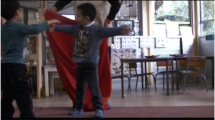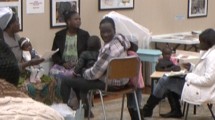Abstract
In science education, students sometimes create and engage in spontaneous science-oriented play where ideas about science and scientists are put to use. However, in previous research, little attention has been given to the role of informal spontaneous play in school science classrooms. We argue that, in order to enhance our understanding of learning processes in school science practices, research that investigates play as an aspect of everyday culture is needed. The aim of this paper is to explore students’ informal play as part of activity in lower secondary school science. The empirical study was conducted in two Swedish compulsory schools in grade 6. Data were collected throughout a teaching unit called ‘The Chemistry of Food’ during a 10-week period using video and audiotape recordings of classroom work. Our analyses show that the play students engage in involves the transformations of given tasks. We find that students’ spontaneous collective play offers opportunities for them to explore the epistemic values and norms of science and different ways of positioning in relation to science. Our findings contribute to the understanding of how learning in the school science classroom is socially and culturally–historically embedded and how individual students’ engagement through play may transform and transcend existing classroom practices.
Similar content being viewed by others
Notes
The NTA programme was developed, based on the US program ‘Science and Technology for Children’, by the Royal Swedish Academy of Sciences and the Royal Swedish Academy of Engineering Sciences in 1997.
The test procedure involves rubbing dry food samples against brown paper and putting drops of liquid food samples on the paper. If the food contains fat a greasy stain will be left on the paper (for liquids, this is the case after the paper has dried).
References
Andrée, M. (2012). Altering conditions for student participation and motive development in school science: Learning from Helena’s mistake. Cultural Studies of Science Education, 7(2), 425–438.
Aubusson, P., Fogwill, S., Barr, R., & Perkovic, L. (1997). What happens when students do simulation–role-play in science? Research in Science Education, 2(4), 565–579.
Barab, S., Sadler, T., Heiselt, C., Hickey, D., & Zuiker, S. (2007). Relating narrative, inquiry, and inscriptions: Supporting consequential play. Journal of Science Education and Technology, 16(1), 59–82.
Baumer, S., & Radsliff, K. (2009). Playworlds of children and adults: Cultural perspectives on play pedagogy. Mind, Culture, and Activity, 17(1), 11–13.
Burton, L.D. (1997). Hitting the issues head on: Using role play in science education. Paper presented at the Annual Meeting of the National Science Teachers Association, New Orleans, LA, 3 April, Electronic version.
Craighead, J. (2008). Distributed, game-based, intelligent tutoring systems—The next step in computer based training? Collaborative Technologies and Systems, 2008, International Symposium, 19–23 May, pp. 247–256. Retrieved January 26, 2012, from http://ieeexplore.ieee.org/stamp/stamp.jsp?tp=&arnumber=4543938&isnumber=4543895. doi:10.1109/CTS.2008.4543938.
Ferholt, B. (2007). Gunilla Lindqvist’s theory of play and contemporary play theory. Unpublished paper. Retrieved October 19, 2011, from http://lchc.ucsd.edu/Projects/PAPER1%20copy-1.pdf.
Ferholt, B., & Lecusay, R. (2009). Adult and child development in the zone of proximal development: Socratic dialogue in a playworld. Mind, Culture, and Activity, 17(1), 11–13.
Fleer, M. (2008). A cultural–historical perspective on play: Play as a leading activity across cultural communities. In I. Pramling & M. Fleer (Eds.), Play and learning in early childhood settings international perspectives. International Perspectives on Early Childhood Education and Development, 1, 1–17. doi:10.1007/978-1-4020-8498-0.
Fleer, M. (2009). Understanding the dialectical relations between everyday concepts and scientific concepts within play-based programs. Research in Science Education, 39(2), 281–306. doi:10.1007/s11165-008-9085-x.
Gilmore, P. (1983). Spelling ‘Mississippi’: Recontextualizing a literacy-related speech event. Anthropology and Education Quarterly, 14(4), 235–255.
Goldhaber, J. (1994). If we call it science, then can we let the children play? Childhood Education, 71, 24–27.
Gutierrez, C., Rymes, B., & Larson, J. (1995). Script, counterscript, and underlife in the classroom: James Brown versus Brown v. Board of Education. Harvard Educational Review, 65(3), 445–471.
Halvars-Franzén, B. (2010). Barn och etik: möten och möjlighetsvillkor i två förskoleklassers vardag [Children and ethics: Ethical encounters and conditions in the everyday life of two preschool classes]. Doctoral Dissertation, Stockholm University.
Hasse, C. (2002). Gender diversity in play with physics: The problem of premises for participation in activities. Mind, Culture, and Activity, 9, 250–269.
Hedegaard, M., & Chaiklin, S. (2005). Radical–local teaching and learning. A cultural–historical approach. Aarhus: Aarhus University Press.
Henniger, M. L. (1987). Learning mathematics and science through play. Childhood Education, 63(3), 167–171.
Ioannidou, A., Repenning, A., Webb, D., Keyser, D., Luhn, L., & Daetwyler, C. (2010). Mr. Vetro: A collective simulation for teaching health science. Computer-Supported Collaborative Learning, 5(2), 141–166.
Johnson, C. I., & Mayer, R. E. (2010). Applying the self-explanation principle to multimedia learning in a computer-based game-like environment. Computers in Human Behavior, 26(6), 1246–1252.
Lindqvist, G. (1996). Lekens möjligheter. [The possibilities of play]. Lund: Studentlitteratur.
Maybin, J. (2007). Literacy under and over the desk: Oppositions and heterogeneity. Language and Education, 21(6), 515–530. doi:10.2167/le720.0.
McSharry, G., & Jones, S. (2000). Role-play in science teaching and learning. School Science Review, 82(298), 73–82.
Moyles, J. (2005). Introduction. In J. Moyles (Ed.), The Excellence of Play. Second Edition. (pp. 1–12). Berkshire: McGraw-Hill.
Nicolopoulou, A., de Sá, B., Ilgaz, H., & Brockmeyer, C. (2009). Using the transformative power of play to educate hearts and minds: From Vygotsky to Vivian Paley and beyond. Mind, Culture, and Activity, 17(1), 42–58.
Nilsson, M. (2009). Creative pedagogy of play—The work of Gunilla Lindqvist. Mind, Culture, and Activity, 17(1), 14–22.
Nilsson, E.M. (2010). Simulated "real" worlds: Actions mediated through computer game play in science education. Doctoral Dissertation, Malmö Studies in Educational Sciences, 50, Malmö University.
Persson, C. (2010). Environmental learning related to earth system science in primary school. Journal of Baltic Science Education, 9(3), 196–211.
Pramling-Samuelsson, I. & Fleer, M. (2008). Commonalities and distinctions across countries. In Pramling, I., & Fleer, M. (Eds.), Play and learning in early childhood settings international perspectives. International Perspectives on Early Childhood Education and Development, 1, 173–190. doi:10.1007/978-1-4020-8498-0.
Roth, W-M., Ritchie, S., Hudson, P. & Mergard, V. (2011). A study of laughter in science lessons. Journal of Research in Science Teaching, 48(5), 437–458.
Roussou, M. (2004). Learning by doing and learning through play: An exploration of interactivity in virtual environments for children. ACM Computers in Entertainment, 2(1), 1–23.
Segal, G., & Cosgrove, M. (1994). “I want to find out how the sun works!” Children’s sociodramatic play and its potential role for the early learning of physical science. Research in Science Education, 24, 304–312.
Singer, D., Golinkoff, R. M., & Hirsh-Pasek, K. (Eds.) (2006). Play=Learning: How play motivates and enhances children’s cognitive and social-emotional growth. New York, NY: Oxford University Press.
Steinkuehler, C., & Chmiel, M. (2006). Fostering scientific habits of mind in the context of online play. In Proceedings of the 7th International Conference of the Learning Sciences (pp. 723–729).
Talamo, A., Pozzi, S. & Mellini, B. (2009). Uniqueness of Experience and Virtual Playworlds: Playing is not just for fun. Mind, Culture, and Activity, 17(1), 23–41.
Tellgren, B. (2004). Förskolan som mötesplats. Barns strategier för tillträden och uteslutningar i lek och samtal [Pre-school as a meeting place—Children’s access–strategies and exclusions in play and conversation]. Doctoral Dissertation, Örebro University.
Vygotsky, L.S. (2002). Play and its role in the mental development of the child. Online Version: Psychology and Marxism Internet Archive. Retrieved November 2, 2011, from http://www.marxists.org. (Original work published 1933).
Vygotsky, L. S. (2004). Imagination and creativity in childhood. Journal of Russian and East European Psychology, 42(1), 7–97 (Original work published 1930).
Wickman, P.-O. (2007). NTA—A Swedish school programme for science and technology. In J. Gedrovics, G. Praulite, & A. Voitkans (Eds.), Didactics of science today and tomorrow (Proceedings of International Scientific Conference, 15–16 March) (pp. 206–210). Riga: RPIVA.
Wood, E. (2009). Conceptualizing a pedagogy of play. International perspectives from theory, policy and practice. In D. Kuschner (Ed.), From children to red hatters. Diverse images and issues of play. Play and culture studies, vol. 8. Lanham: University Press of America.
Wood, E. (2012). The state of play. International Journal of Play, 1(1), 4–5.
Acknowledgments
We wish to express our gratitude to Professor Per-Olof Wickman at the Department of Mathematics and Science Education, Stockholm University, for conducting the fieldwork together with Lotta Lager-Nyqvist, and giving insightful comments on drafts of this article. The study was part of the project Learning, interactive technologies and the development of narrative knowing and remembering (LINT) which has been supported by grants from The Knut and Alice Wallenberg Foundation, The Bank of Sweden Tercentenary Foundation and The Swedish Research Council.
Author information
Authors and Affiliations
Corresponding author
Rights and permissions
About this article
Cite this article
Andrée, M., Lager-Nyqvist, L. Spontaneous Play and Imagination in Everyday Science Classroom Practice. Res Sci Educ 43, 1735–1750 (2013). https://doi.org/10.1007/s11165-012-9333-y
Published:
Issue Date:
DOI: https://doi.org/10.1007/s11165-012-9333-y




